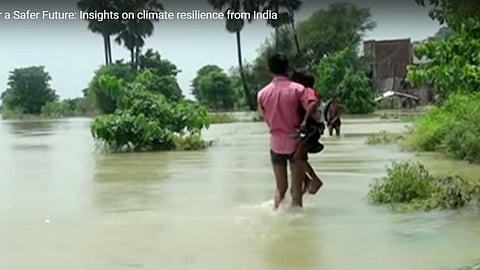
- Topics
- Feature
- Opportunities & Events
- About
- Hindi Portal
- Data
- Topics
- Feature
- Opportunities & Events
- About
- Hindi Portal
- Data

Gorakhpur of Eastern UP is not new to floods. Her people have understood and adapted to the flow and ebb of the waters that have been a part of their lives for long. People here have learned to live with the flood in tune with nature’s wayward ways. Though nature continues to play truant, recent years have seen an increasingy abrupt, uncertain and accelerated face of these disasters. Flash floods, landslides, water logging–all have become more frequent. Shifting seasons, rising temperatures and stronger storms all point to a change in the climate and it is the farmer who faces the brunt of these unpredictable changes. Can they survive these erratic weather patterns? Is it possible to be just a little more resilient to these ever changing climate nuances?
‘For a safer future: Insights on climate resilience from India’, a film released by the Gorakhpur Environmental Action Group (GEAG) and TERI India, in association with The Climate and Development Knowledge Network (CDKN) and ICLEI-Local Governments for Sustainability, attempts to tell the tale of Gorakhpur, an area inundated with recurrent floods. It looks at the impact of this inconsistent weather pattern, the effect of climate change on people and how a concentrated effort with inputs from the government machinery, the farmer community and civil society can, and have made changes for a resilient future ahead. From simple hand drawn maps on the floor, stocking chlorine pills in advance to using empty plastics to make a floatation rig, the film takes us through many such simple and practical steps to brace against unforeseen disasters.
'Din din dharti garam ho rahi, abhi to yeh agaaz hai' (The earth is warming, and this is just the beginning), a new song resounds in the farmers lands. Listen to the lyrics and watch the film narrate the experiences of Gorakhpur.
Speaking to India Water Portal, Dr. Shiraz Wajih, President of GEAG and Associate Professor at Gorakhpur University, discusses the film and how communities are moving from a ‘response-centric’ mode to better coping mechanisms.
All these states are mostly flood affected regions generally. However, disasters like land slides, droughts, heat waves are the local disasters in these areas.
The flood trends have changed in terms of the timings of flood extremes (which is now either early or delayed), peaks of floods have changed timings, winters have stopped suddenly and much earlier (Feb-March), humidity has increased as also the temperature extreme days (both low and high) too have increased.
The DMP approach has been response-centric traditionally. After the Disaster Management (DM) Act (2005), things are changing and the approach of Disaster Risk Reduction (DRR) brings the whole DM closer to preparedness. But still the capacity and mind set of functionaries at district and sub-district levels are limiting factors.
If we prepare for DM in advance and proper planning is made in the DDMPs, things will definitely change. For stregthening mitigation, it is also important that DM is mainstreamed in developmental planning and for this, capacity and willingness of developmental departments are important.
The DM mechanisms are largely top down, relief-centric and await the impact intensity to respond. If the spirit of the DM Act which comprises a 3 tier system of preparedness (viilage, district, state) is followed and communities are involved in DM planning, starting from village to district and state levels, and resource allocation happens accordingly, the needs and priorities of communities will be addressed and ownership of DM processes by the comunity will help.
Policies exist, it is the capacity and attitude primarily which limit the effectiveness of DM measures.
It has to. There is no other way to address the vulnerabilities of communities. Good development is resilient development and there are hundreds of examples where a good development (according to local agro-geo-ecology and socio-cultural aspects) addressing the needs and priorities of local are helpful in risk reduction.
There are different and tested methods of providing drinking water in flood affected areas (raided hand pumps, clorine tablets, cheap water purifiers etc). However, ecosystems conservation is important in this direction for both flood and drought affected areas. For example in flood areas, discouraging open defecation, preventing improper sewage disposal and pollution in water bodies/open areas, will prevent contamination of safe water. Similarly in water scarce areas, conservation of traditional ponds, humidity and moisture conservation in agricultural fields etc. will help.
The main idea behind the film was a means of effective communication and sharing our experience and learnings at a much larger scale.
For DM to be a forward looking process, integrating climate trends and addressing increasing uncertainties are important. The DM planning process has to be bottom-up, involving communities and front line functionaries both. The DM must be mainstreamed in developmental planning and implementation.
True! But the preparedness has to be that which involves communities!